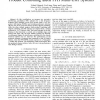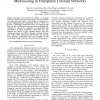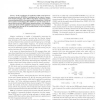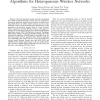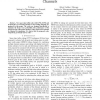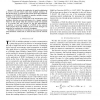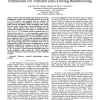124
click to vote
VTC
2006
IEEE
15 years 7 months ago
2006
IEEE
— Bit interleaved coded multiple beamforming (BICMB) was previously designed to achieve full spatial multiplexing of min(N, M) and full spatial diversity of NM for N transmit and...
115
click to vote
VTC
2006
IEEE
15 years 7 months ago
2006
IEEE
— In this contribution, we propose two successive interference cancellation (SIC) schemes for a fast frequency hopping (FFH) multiple access (MA) system using M-ary frequency shi...
113
click to vote
VTC
2006
IEEE
15 years 7 months ago
2006
IEEE
—Disruption Tolerant Networks (DTNs) are emerging solutions to networks that experience frequent network partitions and large end-to-end delays. In this paper, we study how to pr...
VTC
2006
IEEE
15 years 7 months ago
2006
IEEE
Abstract—In this contribution, the application of fully connected recurrent neural networks (FCRNNs) is investigated in the context of narrowband channel prediction. Three differ...
103
click to vote
VTC
2006
IEEE
15 years 7 months ago
2006
IEEE
— The next generation wireless networks will support the vertical handoff mechanism in which users can maintain the connections when they switch from one network to another (e.g....
VTC
2006
IEEE
15 years 7 months ago
2006
IEEE
— Iterative equalization has emerged as an efficient means of achieving near-capacity detection performance in multiple-antenna (MIMO) systems. However, many proposed detection ...
VTC
2006
IEEE
15 years 7 months ago
2006
IEEE
— New space-time trellis codes with 4-PSK, 8-PSK and 16-QAM for two transmit antennas in slow fading channels are proposed in this paper. The codes are designed specifically to ...
107
click to vote
VTC
2006
IEEE
15 years 7 months ago
2006
IEEE
— We consider the application of spatial multiplexing to ad hoc networks where nodes have multiple antennas. At the physical level, we suppose that layered space–time multiuser...
VTC
2006
IEEE
15 years 7 months ago
2006
IEEE
115
click to vote
VTC
2006
IEEE
15 years 7 months ago
2006
IEEE
Abstract— This paper proposes a maximum likelihood detection (MLD) method for the differential space-time block code (DSTBC) in cooperation with blind linear prediction (BLP) of ...

